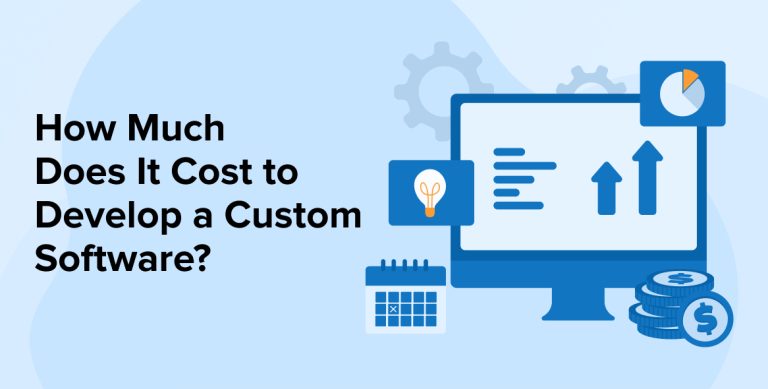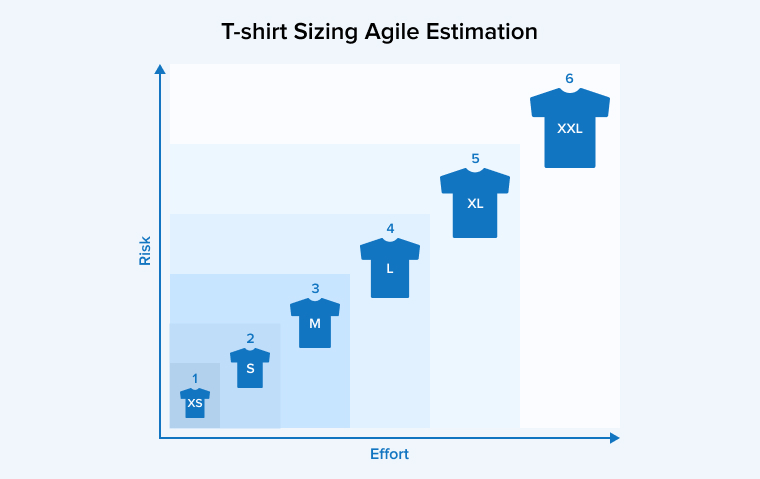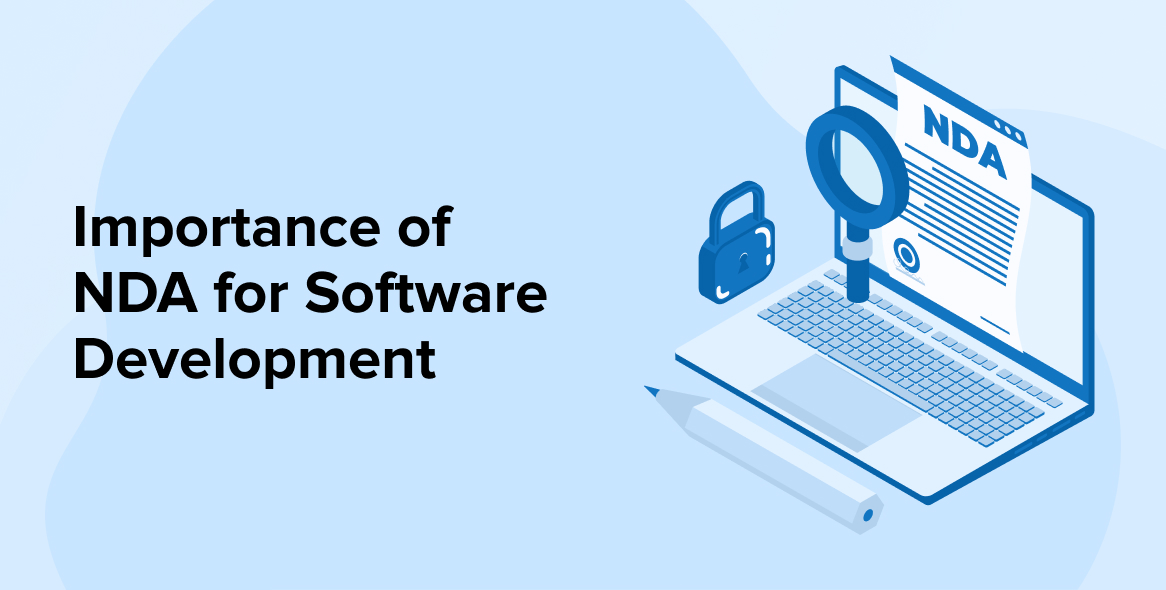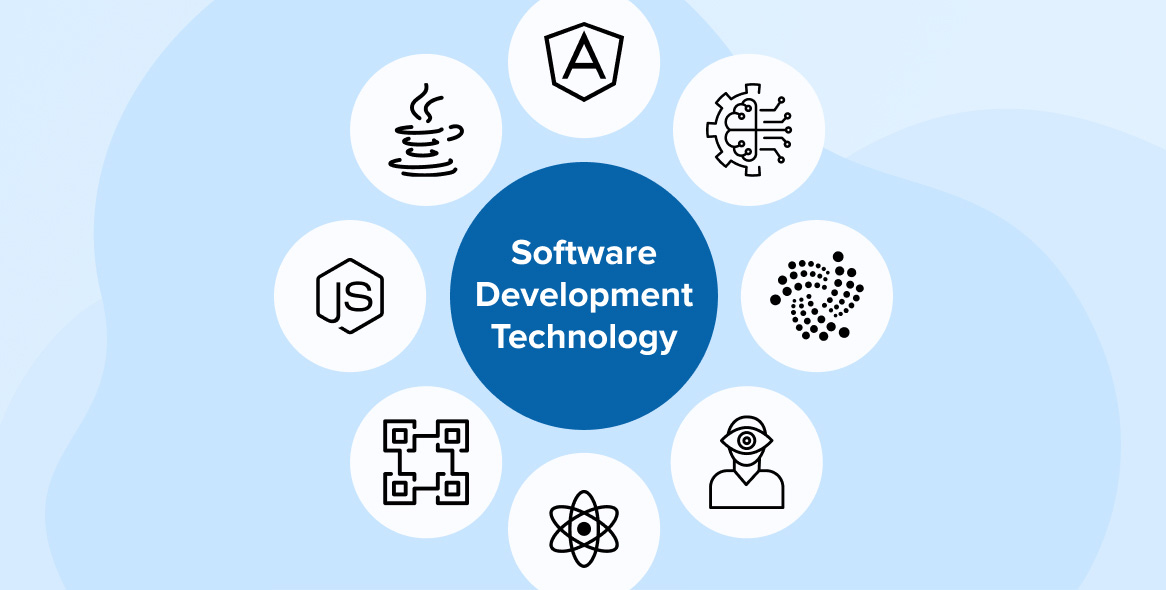
Everyone looking for custom software development is curious about its costs and development budget. The term custom software here represents a wide range of software solutions that are catered specifically to fulfill the unique requirements of the business. Therefore, every software project is distinct and hence the prices vary from project to project.
However, you can get an accurate software development cost estimation for your project by discussing your requirements with a software development company. And with decades of experience in catering to client’s needs, we know the concerns of someone looking for a custom software solution.
Therefore, we have crafted a guide that can help you get a general idea of the custom software development costs. This blog post discusses every approach and every factor you need to consider while calculating the development cost of building custom software.
1. Average Cost Of Custom Software Development
Determining which type of software you need to create is an easy way to identify the potential range of custom software development cost. Of course, the required functionalities on both the front and back end may cause the development costs to vary. But you will get the general idea from identifying the software type.
But before we go through the general costs of software products, let us take a look at how much software development may potentially cost in different industries.
Rough price example for some leading industries.
Healthcare : Electronic healthcare record management (EHRM) kind of platform can cost you in the range of 300k-400k $
Logistics: Fleet management kind of web & mobile application can cost around 100k-150k $
FinTech: Any Forex trading application can cost around 100k-150k & any financial planning app can cost you around 80-100k
Retail & Ecommerce – Any single vendor ecommerce or retail web application with open source platform can cost around 30-40k
Education: Here are some rough software development costs for different types of software products.
Marketplace App – A customer-facing app where multiple vendors or sellers connect with the customers is called a marketplace app. The platform handles all the promotional activities and financial transactions. Amazon and Airbnb are perfect examples of a marketplace app.
Approx Time (Hours):2500-3000
Approx Cost (USD):50-60k $
Content management system (CMS) – A software system that helps you manage and update the content of your website without any need for manual programming is called a Content Management System. Some popular CMS solutions are Drupal and WordPress.
Approx Time (Hours):300-500
Approx Cost (USD):6-10k $
Customer relationship management system (CRM) – According to the needs of an organization, a CRM system may vary. But overall, it helps you streamline your sales, marketing, and customer service. CRM system helps teams access data in real-time and improve organizational efficiency. Salesforce and Hubspot are two popular CRM solutions.
Approx Time (Hours):5000-8000
Approx Cost (USD):125k-200k $
Custom eCommerce Store – A customized online store built using eCommerce technologies such as Magento to fulfill their unique business requirements is called a custom eCommerce store. Big companies such as Graze and Land Rover have successfully built custom eCommerce store websites.
Approx Time (Hours):1000-1500
Approx Cost (USD):20k-30k $
Software as a Service (SaaS) – Instead of downloading, software that is run on either a browser or on the cloud to provide services across the internet is called Software as a Service app. Dropbox, MS Office 365, and other business tools are SaaS applications.
Approx Time (Hours):5000-10000
Approx Cost (USD):125k-250k $
Enterprise Resource Planning (ERP) – A system that brings a company’s business processes such as finance, HR, supply chain, operational, and more on one platform is called ERP software. It helps the company manage and automate all business processes. This helps the owners have a complete overview of all their processes and plan how they can accomplish their goals effectively. To give some examples of ERP solutions; Sage 300, Oracle Netsuite, and Katana.
Approx Time (Hours):20000-25000
Approx Cost (USD):500k-625k $
2. Factors that Affect Software Development Cost
Undoubtedly, when you develop custom software there can be countless factors that are fundamentally involved in software development for any specific business or enterprise software project. If you have to develop a multi-feature web application then there need to be multiple resources involved and hence the software development cost will be as per the features and development.
2.1 Targeted Platforms
The platform where you want to launch your software application affects your software development budget. Every platform has different requirements. With an increased number of targeted platforms, the work of software engineers also increases which results in increased custom software pricing. To ensure their effective operation across multi-platform operating systems, you might also have to invest in database middleware and third-party integrations.
2.2 Project Size
The size of the custom development project also influences the development costs. The bigger the software project, the more developers have to work on it. In total, there are four kinds of project size.
- Small – A small project demands some minor changes or bug fixes.
- Medium – In this category, the work of developers is a little intense as they have to build standalone solutions such as a web interface or a simple mobile app for an existing system.
- Large – Developing a multi-platform app or a complex business system is included in a large project. Such products need to be integrated with various systems, a database, and high-security functionalities.
- Enterprise – Enterprise projects deal with the development and deployment of Uber-like projects that have several third-party integrations, work on all platforms, and adhere to strict security measures for the protection of user data.
2.3 Software Project Complexity
Another essential software development cost factor that plays a major role is the software complexity. The main aspect is the logic or the method that is used to develop software and web applications. Suppose the application needs to be tweaked or there are some quirky steps to be taken to develop the software then the custom software development team or the outsourcing team may charge extra depending on the complexity of the desired project. So, if the business goes out of its way to develop unique and innovative products, the cost may increase in such cases.
As per the development needs, businesses can have the complexity of features, there can be design complexity, technology concerns, and architectural or database integration concerns.
2.4 Integration- Internal & External
Integration with internal applications and third-party applications is an important consideration and can affect the cost of the development. Since you are just developing the application, you might not know how this would interact with other hardware or software that are going to work together.
For example, if you’re a retail or eCommerce business, then POS software is a significant point of consideration and if you are an eCommerce business then without convenient payment gateways, the app development may not sound complete. Similarly for the banking business payment gateways are vital. So, it is essential to integrate with third-party and internal apps.
2.5 Design Complexity
To design a user-centric, interactive, feature-rich, and compact application, there can be many hurdles faced by the software development company or software developers. These complexities can be solved by strong and in-depth front-end capabilities. This plays an important factor in software costing estimations.
2.6 Hiring Model
The hiring model you choose for your project also affects the project price. Mainly, there are three options; you can hire in-house developers, outsourcing teams, or freelancers. Let’s discuss your hiring options briefly.
- In-house teams: Hiring an in-house team is one of the most expensive hiring options. Apart from the system set up and salaries there are many hidden costs such as payroll taxes and more. But you will have control and close supervision of the workflow. In terms of the data security of your project, hiring an in-house team might be the best option.
- Outsourcing: Outsourcing teams offer more affordable software solutions. If you pick your outsourcing partner wisely, the project collaboration and management can be smooth. However, it takes a thorough background check to verify whether the vendor possesses the talent and experience needed to lead your project to success. Communicating while working in different timelines is still a big challenge with outsourcing models.
- Freelancers: Many talented software developers work as freelancers. They offer quality services at reasonable rates. However, being not part of a larger team is a major downside for them. It makes them narrowly focused on the task. When hiring freelancers, you also need to hire project managers who can ensure that the project is on track. That is an additional cost in this hiring model.
It is not quite a rule that you have to pick just one hiring model. You can effectively combine them to suit your requirements.
2.7 Development Team Size
The type and size of your bespoke software project determine the size of your development team. The more people you need to work on your project, the higher your custom software development costs go. Depending on the project requirements and scope of work, you might have to hire personnel to fulfill roles like:
- Small project – 3 people wherein one developer, one QA expert, and one project manager
- Medium project -5-8 people wherein one project manager, one business analyst, 2 developers, a QA tester, and other members as per requirements.
- Large project – 8-12 people wherein a project manager, business analyst, UI/UX designer, database expert, software architect, multiple developers, and QA testers.
- Enterprise project – 12+ people wherein a project manager, UI/UX designer, database expert, software architect, multiple business analysts, developers, and QA testers.
This is a general assumption, the roles and number of team members may vary depending on your scope of work and project requirements.
3. Hidden Costs of Custom Software Development
There are some hidden costs associated with custom software development that aren’t calculated initially. However, you should consider these costs upfront to get more accurate estimates. The hidden cost of software development refers to the marketing expenses and fees for support and maintenance.
3.1 Marketing
If you are in business to sell software to a targeted audience then you have to consider the cost of promoting the product and increasing its visibility. Sometimes the marketing cost of custom software tends to go higher than the initial development price. The marketing costs will include money spent on:
- PR
- Social media marketing
- On-page and off-page SEO
- Email marketing
- Content marketing and sales funnels
- Expenses for the marketing team
3.2 Maintenance and Support
You have to have post-deployment services like maintenance and support to ensure that the functionality and performance of your software remain seamless. Updating software, adding new technologies or other requirements, fixing bugs, overcoming security vulnerabilities, and more are included in technical support and maintenance of the software. Sometimes it demands the involvement of third-party assistance and resources which increases your costs.
4. Different Hiring or Payment Models of Custom Software Development
All the trustworthy technology pioneers have discovered a set way to engage with businesses. Enterprises have broken the relationship models into three groups based on financial factors and necessary circumstances.
4.1 Fixed Cost

The fixed price model goes according to the name which involves addressing the needs, scale, deadlines, and expenses of the project all at scratch. This strategy will work like a magic wand if you have a blueprint for your market since a fixed price model works on the basics of initial preparation, estimate, and analysis.
4.2 Dedicated Team

Most companies choose a dedicated team type of payment method to partner with software outsourcing businesses for their medium and/or large-scale tasks of varying sizes. The main reason is the flexibility and convenience that it offers to the clients for their software development programs.
4.3 Time and Material Model

The time and material outsourcing model is easy, where organizations just have to pay according to the time spent and the material used in the production process. This style of the model makes it possible for you to pay every month according to the use of materials and time spent.
5. How is Cost Estimation Done For Software Development Projects?
Since we have talked about the custom software development prices factor so much in the blog, it’s now time to understand how this cost is decided. How do software development companies and software developers decide a price for a product? You can plan according to technology, margin, project, and other essential factors. There are five types of estimations:
5.1 Bottom-Up Estimating
If you have a huge project, you can first split down the project into smaller assignments. Then scheduling smaller sprints of larger projects is considered a framework for job breakdowns. The latter is important not only for the calculation of time and expense but for many other activities of project management. You will get the overall development cost of the project by adding the hourly rate and summing up those granular time estimates. Bottom-up estimation is one of the common practices.
5.2 Top-Down Estimating
When there is a fixed budget for a project, top-down estimation is typically used. A budget based on historical data about similar projects or input from experts can be provided by top-level management. The estimation process in this case is the determination of the scope of the project that fits the budget specified. This explains in other words, what you can do with the money you have.
5.3 Analogous
This is a simpler way of measurement that depends on the previously completed tasks of the same project and making an estimation regarding the same.
5.4 Parametric
Parametric Estimation is a process that enables the total work expense to be calculated based on scaling the features of other tasks from well-known programs.
5.5 Three-Point Estimating
This method is based on a triangular estimation method where the values are profitable estimates, Loss-based negative estimates, and random estimates. If we were to take it by equation then it would be:
E= (P+N+ES) / 3
P- Positive estimate
N- Negative estimate and
ES- A random assumption based on the market price
5.6 T-shirt Sizing Agile Estimation

When you go to the store to buy a t-shirt, you can see different sizes of t-shirts such as small (S), Medium (M), Large (L), Extra Large (XL), and so on. These categories indicate relative sizing that fits different sizes of shoulders. They are easy to use in comparison to numerical sizes like 36, 38, 40, and so on.
Similarly, T-shirt sizing agile estimation allows you to put different user stories and items in different categories and eliminate the numerical scoring technique. Allowing the developers to categorize stories makes them more flexible and dynamic.
The process you have to follow to conduct t-shirt sizing agile estimation is as given below:
- Conduct an estimation session. Gather all the team members there and distribute the cards for different t-shirt sizes to them.
- Provide a brief explanation about the user story to the team. The product owner does the estimation of the user story. After the briefing is completed, conduct a Q&A session with the team members to provide more clarity and understanding of the user story.
- To ensure that everyone has a clear understanding about the user story, ask them to assign a t-shirt size to it.
- Ask every team member to display their assigned t-shirt size.
- If all team members have picked the same size then consider it to be the final estimate. If some members have chosen different sizes then you can hold team discussions to reach a consensus on one size.
- Take one user story after another and repeat the process until you have a t-shirt size estimation for every user story.
- If you wish, after the completion of t-shirt size estimation you can also ask your team members to estimate the time required to complete these stories.
This technique of relative sizing is very easy and quick, and most importantly, it ensures that the team reaches a consensus.
6. How Much Does Custom Software Cost in India?
The Indian IT Services and Business market to reach US$26.45bn in 2024; predicts Statista.
The custom software development cost in India compared to other countries is extremely economical and that is the sole reason why the Indian market is skyrocketing. As per the reports from Time Doctor, the top countries preferred based on the cost factor for outsourcing are,
- India
- Mexico
- Malaysia
- Philippines
- Bulgaria
- Brazil
- Ukraine
The monthly developer rates in India are approximately $3000-$5000 in comparison to the monthly developer rates in the USA which are approximately $8000-$10000. The talented and diligent resources of India are unquestionable. Certain unavoidable benefits apart from cost benefits that the Indian Outsourcing market offers are,
- Talented workforce new-edge IT companies
- Humongous software size
- 24*7 Customer support
- Supportive government and rules
- Reliable and trustworthy established companies
7. Final Words
Cost questions have been the most disputable search and in recent times it has been observed the prevalence of this type of question is just increasing. So, to clear this hustle of evaluating the cost factor, we decided to do elaborative research and give some insightful information on how the cost factor impacts custom software development. Hope this blog brings light to all your questions and you can have a ballpark cost estimation of the software development process and can make the right decision.
Frequently Asked Questions:
1. How Much Does It Cost to Create Custom Software?
The cost of custom software development depends on various factors like the size of the project, team, technological requirements, and more. However, the estimates below will give you a general idea of custom software development costs.
- Small project: $10,000-$60,000
- Medium project: $30,000-$100,000
- Large project: $100,000-$500,000
- Enterprise-level project: $500,000+
You can contact an experienced software development company to discuss your requirements and get an accurate estimate for your project.
2. How Do You Calculate Custom Software Development Costs?
You can roughly calculate the custom software development costs by multiplying the average service cost for each team member with the estimated duration of your project (in hours).






I think this article explained very well about custom software and different factors that affect the cost of software. But I think the size of software also plays a major role in the cost of any software product. There are some non-technical factors that could also affect the cost of an app or software.
As far as I know, geographical location may also impact the cost of developing software. Some regions like India and China where you can get software built for a much lower rate without compromising the quality as compared to the USA and UK.